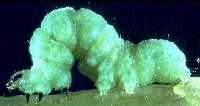by F.B. Peairs and J.L. Capinera * (9/14)
Quick Facts…
- Many species of caterpillars attack Colorado crops; the species involved will affect control decisions. Use the following descriptions to identify pests.
European Corn Borer

Ostrinia nubilalis (Hubner). This caterpillar has a cream-to-grey colored abdomen with light brown spots. It is similar to southwestern corn borer, but during the summer months the latter has much darker spots on a whiter background. The European corn borer primarily attacks field corn in Colorado and damages the leaves, stalks, shanks and ears. It also can become a pest of sweet corn, potatoes, sorghum, snap beans and peppers. Egg laying for the first generation occurs during the first part of June. Second generation egg-laying can extend over a two- to four-week period starting in late July.
Southwestern Corn Borer

Diatraea grandiosella (Dyar). During the growing season, this caterpillar has a white abdomen with conspicuous dark brown or black spots. It is similar in appearance to the European corn borer, but the latter has lighter spots on a browner background. During the winter the southwestern corn borer becomes pale yellow with very faint spots. It is primarily a pest of corn but also attacks sorghum. From one to three generations may occur per year in Colorado, depending on the severity of the previous winter.
Beet Webworm

Loxostege sticticalis (L.). This is a small greenish black caterpillar with a narrow, dark stripe running down the back and long setae that arise from distinct dark circles. It is active when disturbed. This pest will feed on the leaves of carrot, celery, pea, potato, spinach and sugarbeet. Usually three generations of caterpillars occur during the growing season, with the first appearing during June.
Alfalfa Webworm

Loxostege cerealis (Zeller). This is a small, greenish-black caterpillar with a broad light stripe running down the back. It often will feed within leaves that have been webbed together. These may be connected to the ground by a silken tunnel through which it will retreat rapidly when disturbed. It feeds on alfalfa, carrots, celery, field corn and sugarbeets. The first of the two or three generations of caterpillars occurs during May and June.
Bilobed Looper

Autographa biloba (Stephens). This is a greenish caterpillar that tapers from back to front. It walks with a typical looping motion. It can be distinguished from other loopers by a strong black line that runs around the front of the head capsule. It will feed on alfalfa, cabbage, lettuce and peas, but it rarely causes extensive damage. One to two generations occur per year.
Celery Looper

Anagrapha falcifera (Kirby). This pale green caterpillar tapers from back to front. It has a distinct white stripe on either side that contains a row of white spiracles edged in black. The true legs are light green. It walks with a typical looping motion. This pest prefers celery but has attacked sugarbeets and lettuce. Two to three generations per year of this pest occur in Colorado.
Alfalfa Looper

Autographa californica (Speyer). This greenish caterpillar tapers from back to front and has a single white stripe on either side of the abdomen. The true legs and part of the head usually are black. It walks with a characteristic looping motion. It is similar in appearance to the cabbage looper but lacks the reduced prolegs on the third and fourth abdominal segments and usually has dark thoracic legs and a dark band on the side of the head. This looper will attack alfalfa and sugarbeets as well as several horticultural crops. Usually two generations per year of this pest occur in Colorado.
Cabbage Looper

Trichoplusia ni (Hubner). This greenish caterpillar tapers from back to front and has a distinct white stripe on either side of the abdomen except immediately before pupation. It walks with a typical looping motion. The reduced nipple-like prolegs on the third and fourth segments of the abdomen help distinguish it from other looper species. This pest will attack a wide variety of horticultural crops. Two to three generations occur per year in Colorado.
* F.B. Peairs, Colorado State University Extension entomologist and professor, and J.L. Capinera, former professor; bioagricultural sciences and pest management. 1/92. Revised 9/14.
Colorado State University, U.S. Department of Agriculture, and Colorado counties cooperating. CSU Extension programs are available to all without discrimination. No endorsement of products mentioned is intended nor is criticism implied of products not mentioned.
Go to top of this page.





